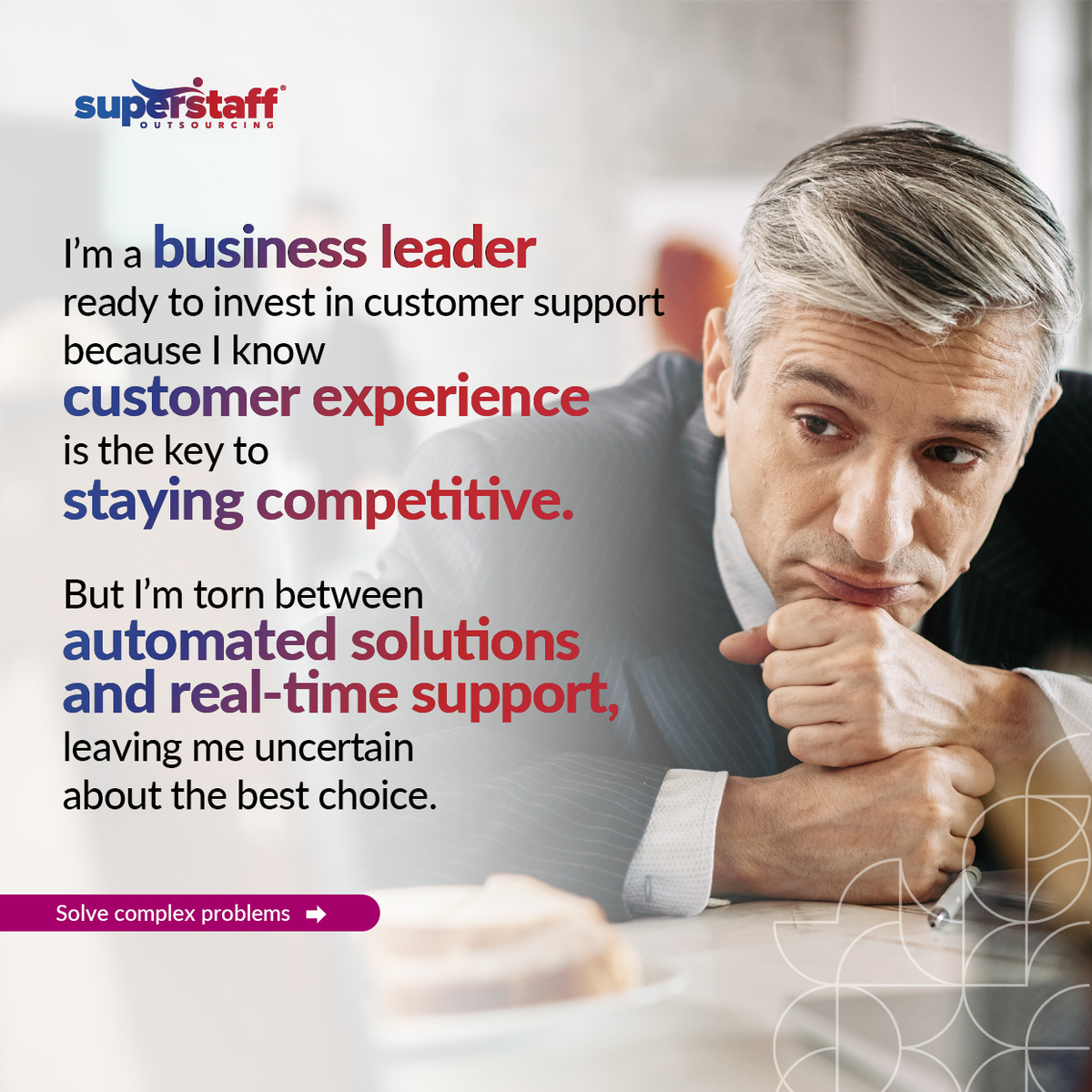
In today’s competitive landscape, customer experience (CX) is the deciding factor between loyalty and lost business. The debate over self-service versus real-time customer support is more critical than ever. As a C-suite executive, navigating this balancing act is key to maximizing both efficiency and customer satisfaction.
Self-service tools promise streamlined solutions, empowering customers to find answers quickly, bypassing lengthy interactions. Meanwhile, real-time support offers a personalized touch that strengthens relationships and fosters deeper connections with your brand.
Both approaches are essential, but which delivers the highest return for your business? In this article, we’ll dissect when to prioritize each, ensuring your CX strategy drives the greatest impact for your bottom line.

The Growing Appeal of Self-Service Support
In the era of increased digitalization, self-service options are becoming increasingly popular among consumers and businesses. As a C-suite leader, you may consider investing in self-service customer support because of its cost-effectiveness and scalability.
Meanwhile, self-service resources are helpful for consumers who need quick answers to commonly asked questions. They can seek out FAQs, knowledge base software, and forums to resolve their urgent yet relatively simple issues.
According to a recent Gartner survey, over 73% of customers have used a self-service solution at some point in their lives. However, only 14% of customer service issues are fully resolved via self-service, prompting a deeper evaluation of its ROI potential compared to real-time interaction.
Today’s buyers seem to seek out these resources to determine whether they can resolve their issues independently and without the assistance of a dedicated customer service representative. Let’s take a closer look at the advantages of self-service support.
Reduced Operational Costs and Reliance on Human Agents
The main advantage of self-service customer support for businesses is the reduced operational costs. Providing buyers a way to find answers on their own means fewer customer service phone calls, a decreased reliance on human agents, and less time and resources spent on resolving tickets.
Forrester’s research found that live agent calls can cost companies up to $25 per interaction, while self-service resources and automated chatbots cost only $5 per contact. Investing in self-service technology can reduce labor costs by 30%, giving companies more leeway to reallocate spending to other areas of their operations.
Scalability and 24/7 Availability of Self-Service Platforms
Here’s another advantage of self-service resources: they are always available whenever a customer needs them.
Human customer service is limited by the number of available agents, their operating hours, and the number of calls they can handle simultaneously. Meanwhile, knowledge bases and other self-service support options are always one click away.
Various studies have found that long wait times directly contribute to poor customer experiences, with 90% of consumers disliking being put on hold and waiting hours to be connected to a live representative.
Then, when a caller gets connected to human customer support, 40% want their issues resolved in one interaction, and 70% hate repeating themselves to different agents.
Self-service resources can allow these frustrated customers to find the correct answers without long wait times or time-consuming phone conversations. Avoiding lengthy customer service calls can be a godsend to buyers who prefer resolving issues immediately and without assistance.
Common Challenges Customers Face With Self-Service Solutions
Despite the clear advantages of self-service support, this customer service solution still comes with its fair share of challenges. As mentioned, the 2024 Gartner survey shared above found that although most people have used self-service options, only 14% of customer service issues were resolved.
Customers say they feel a disconnect between the problems they want to solve and the knowledge available to them in self-service platforms. Over 43% of survey respondents say they could not find official content related to their specific issue.
These numbers illustrate the primary limitation of self-service solutions. Although online knowledge bases are helpful for simple and common problems, most customers need immediate answers to more complex concerns.
The Value Proposition of Real-Time Customer Support

As discussed in the previous section, self-service solutions can help companies reduce costs and scale support capabilities. However, these platforms cannot cover all possible customer concerns, particularly more complex and sensitive issues.
Relying solely on self-service customer support can create many unresolved customer issues that may undermine your long-term ROI. As such, it’s essential also to consider the unique value proposition of real-time customer service. Here are the powerful advantages of this support solution:
Adding a Human Touch to Every Customer Interaction
In the automation and digital transformation age, people now have more options when seeking customer service. Many companies are investing in artificial intelligence (AI) chatbots to respond quickly and efficiently to common inquiries and problems.
However, even with the emergence of advanced technologies like AI, the human element of customer service is still essential. According to a Redpoint Global study, 77% of consumers agree that genuine and empathetic human interactions are vital to creating positive customer experiences.
Real-time support offers customers a more personalized and immediate interaction, which is critical for resolving more intricate concerns. When callers express frustration, anger, sadness, or other emotions, human support agents can respond with empathy, kindness, and professionalism, helping enhance overall customer satisfaction and loyalty.
Building Stronger Customer Relationships Through Real-Time Communication
Another advantage of human customer service is its ability to strengthen customer relationships and trust. Since support representatives respond to concerns in real time, buyers will feel more connected to and engaged with your brand.
Picture this: a customer has an urgent question about your latest product. They want to use a specific feature, but they’re having trouble making it work. They try searching for answers online, but the instructions are complex, leaving them feeling frustrated and confused.
With real-time customer support, the buyer can receive step-by-step guidance on operating the product’s features. Instead of doing trial-and-error on their own, they can tell your support representative what the issue is, whether it can be easily fixed, or whether they’ll need further assistance.
Communicating with a human agent while solving a complex problem can help them feel at ease when diagnosing problems. Knowing there’s someone on the line who can assist them if things continue going wrong deepens their trust in your brand and creates a more positive overall experience.
Providing Immediate Responses and Efficient Resolutions
Finally, real-time support facilitates immediate resolutions, preventing churn and increasing customer lifetime value. As mentioned, self-service platforms can quickly answer simple questions, but human customer service is essential for resolving more complex issues.
AI-powered chatbots can’t resolve novel problems because they can only provide answers based on their existing database. The same is true for other self-service platforms like knowledge bases. Meanwhile, human agents can draw on previous experiences and use their critical thinking and problem-solving skills to handle uncommon issues, leading to more efficient resolutions.
Despite the advantages of real-time support, it comes with higher costs and staffing demands, leading to the question of balancing the two approaches. For C-suite leaders like you, navigating this complex balancing act is critical for optimizing customer experience and maximizing ROI.
Finding the Balance Between Self-Service and Real-Time Support
Instead of investing in only self-service platforms or real-time support, achieving maximum ROI involves a strategic blend of both solutions. However, striking that delicate balance is easier said than done. It will require examining your existing customer service strategy, identifying which areas to optimize, and collaborating with CX professionals to oversee its execution.
To help you get started, here are some of the best practices for balancing self-service and real-time support:
#1: Understand your customers’ specific needs and preferences.
Think about your specific business model and industry. Finding the right balance between self-service and real-time support will involve tailoring your CX strategy to your buyers’ needs and expectations.
Ask yourself: What are your customers’ most common issues and pain points? How do they prefer to communicate with you? Will you make their lives easier by implementing automated systems and self-service customer support options?
If you’re unsure about what your customers may think, we recommend collecting data through surveys, feedback forms, and customer interviews. You can also leverage data science and analytics to view CX trends in your industry comprehensively.
#2: Identify routine vs. complex issues and align resources accordingly.
Once you’ve assessed your customers’ needs and communication preferences, the next step is identifying which issues should be featured in self-service resources and which require real-time support.
Take a closer look at the data you collected from the first step. Your knowledge base should highlight the most frequently occurring issues. Organize your content with relevant keywords, categories, and tags so customers can easily find it when needed.
Meanwhile, more complex and uncommon issues will require real-time assistance. In your knowledge base, make sure to include a way for consumers to connect with a human representative when they can’t find the answers they’re looking for. Having a button that redirects them to your live chat function or ticketing system can be an effective strategy.
#3: Adopt an omnichannel approach to customer service.
The key to striking the perfect balance between self-service and real-time support is to view these solutions not as individual entities but as two halves of the same whole. Your knowledge base platforms and human support representatives must work together to create a positive customer experience.
As such, you must embrace an omnichannel approach to customer service. This means investing in multiple platforms, including phone, email, social media, live chat, and self-service support, and integrating traditional and digital channels into one seamless customer journey.
#4: Continuously monitor and evaluate the performance of your CX strategy.
Finally, once you’ve developed and deployed your customer experience strategy, make sure to monitor its effectiveness continuously. Set relevant key performance indicators (KPI) and metrics for each customer support channel and keep track of its progress and performance. To maximize ROI, it’s essential to regularly evaluate and adjust the balance between self-service and real-time support.
Measuring ROI Across Both Approaches
Having discussed the best practices for balancing self-service and real-time customer support, it’s time to tackle how to measure your return on investment across both solutions. Measuring ROI requires understanding direct and indirect benefits, from cost savings to customer satisfaction metrics. Here are some of the specific KPIs and metrics you should pay attention to:

Metrics for Self-Service Customer Support
Track the following metrics to measure and assess the effectiveness of your self-service support. Weighing these against the cost of setting up your knowledge base can help you determine and maximize your ROI.
- Number of Requests Raised Via Self-Service: How many people have issued a customer service ticket after viewing your knowledge base content?
- Percentage of Customer Contacts Via Self-Service Portal: Based on the total number of customer service tickets, what percentage of people came from the self-service portal? In general, a lower rate means that most customers find your knowledge base useful, and only those with complex issues feel the need to reach out for real-time assistance.
- Content Relevance: How often do you review and update your knowledge base content to reflect your customers’ changing needs, expectations, and concerns?
- Bounce Rates: How many users leave abruptly after clicking on your self-service resources? A higher bounce rate means that customers didn’t find the answer they sought in your knowledge base content.
- Self-Service Customer Satisfaction Score: How satisfied are your customers with the answers you provided in your online knowledge base?
- Overall Self-Service Portal Performance: Which self-service resource pages were the most read, and which were the most poorly rated? Regularly review and update your knowledge base content to optimize high-performing pages and eliminate obsolete or irrelevant content.
KPIs for Real-Time Customer Support
In addition to monitoring self-service metrics, you must keep track of your customer support team’s performance. The following KPIs can give you insight into your human agents’ effectiveness at responding to and resolving customer inquiries and problems:
-
- First Response Time: Once a customer service ticket is submitted to your system, how long will it take your team to respond?
- Average Resolution Time: How long does it take them to resolve a ticket on average?
- First Contact Resolution: What is the percentage of customer tickets that are resolved upon first contact?
- Tickets Handled Per Hour: How many tickets can one support agent handle per hour?
- Tickets Solved Per Hour: How many customer issues can they resolve per hour?
- Cost Per Resolution: What is the total cost of customer service divided by the total number of issues resolved in a given period?
- Call Abandonment Rate: What is the percentage of callers who hung up the phone while on hold with customer service?
How To Measure Customer Satisfaction for Both Models
Remember: ROI isn’t just about reduced expenses; it also involves long-term customer loyalty and brand reputation. To properly measure the value delivered by your self-service and real-time support models, you’ll also need to calculate your investment costs against the increase in customer satisfaction. Here are the metrics for calculating the ROI of customer experience:
- Customer Lifetime Value: What value does a customer bring to your business over the course of your relationship?
- Customer Satisfaction Score: How satisfied are your customers with specific aspects of your business?
- Customer Health Score: How likely is a customer to continue engaging with and purchasing from you?
- Customer Effort Score: How easy or difficult is it for your consumers to do business with you?
- Net Promoter Score: How likely are they to recommend your brand to their friends and loved ones?
The Impact of Poor Issue Resolution on Brand Reputation and Long-Term Costs
With these ROI metrics, businesses like yours can make data-driven decisions to optimize their customer service strategy. Whether through self-service or real-time support, investing in CX can enhance your brand reputation and positively impact your bottom line.
Meanwhile, overlooking CX can lead to poor customer service performance and ineffective issue resolution, which, in turn, can cause buyers to turn away from your business for good. And, as we’re sure you know, fewer customers means a decline in profits and revenue, which impacts your company’s long-term growth and success.
So, take action as early as today. Make plans to enhance your customer support strategy so you can maximize your ROI for the coming year.
Seeking Real-Time and Self-Service Customer Support? Trust the BPO Professionals at SuperStaff
Both self-service and real-time customer support offer value, but their effectiveness in delivering ROI depends on your company’s specific strategy and customer needs. Self-service platforms provide cost-efficiency and scalability, while your live support representatives help enhance buyer satisfaction and loyalty.
By creating a hybrid support model that balances both solutions, you can optimize your customer experience, align your approach to your strategic business goals, and maximize your return on investment. Then, continually assess your CX models, leveraging data to refine the balance between support channels.
If you need help bringing your ideal CX model to life, partner with the professional team at SuperStaff. With our years of experience in the customer service outsourcing industry, we can help you develop, refine, and execute a CX strategy that meets your business needs.
Are you ready to get started? Contact us for a quick consultation and learn more about our comprehensive call center solutions!






